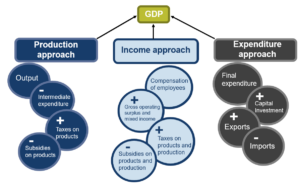Key Facts about GDP
What is GDP?
- A core macro-economic indicator
- It measures the value and volume of goods and services produced in the UK
- It measures the size and growth of the economy
What are the challenges in estimating GDP?
A very complex production system – using surveys, administrative sources and assumptions – estimates GDP
The three approaches to estimate GDP and their individual components
The image above demonstrates the three approaches used to estimate GDP and the individual components of each approach.
Production approach: Output – Intermediate expenditure + Taxes on products – Subsidies on products
Income approach: Compensation of employees + Gross operating surplus and mixed income + Taxes on products and production – Subsidies on products and production
Expenditure approach: Final expenditure + Capital investment + Exports – Imports
Why are early quarterly GDP estimates important?
They are used by the Bank of England when making important monetary policy decisions in the monetary policy report
They are used by the Office for Budget Responsibility when reviewing fiscal policies in the autumn and spring economic and fiscal outlooks
They are used by the Chancellor of the Exchequer when setting fiscal policies in the spring budget and autumn statement
Why are estimates of GDP revised?
Early estimates of GDP are mainly compiled using growth indicators for output (the production approach)
With time, more detailed information becomes available, building a more comprehensive picture of the economy. This can take up to two years after the reference period.
Early GDP estimates are revised to include information from other parts of the economy, such as structural business surveys and administrative data on wages and taxes, as they become available.
Back to top




